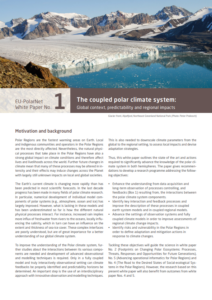A white paper published by the EU-PolarNet touches upon some of the most pressing issues that the Polar Regions face nowadays. There regions are the fastest warming areas on Earth and their natural physical processes impact climate conditions and affect lives and livelihoods across the world. If these processes are changed due to global warming, they could lead to changes across the planet with unknown impacts.
According to the report, in order to improve the understanding of the Polar climate system, more studies regarding the interactions between its components are needed, along with development of observational and modelling techniques.
In fact, EU-PolarNet mentions that:
Only in a fully coupled model and truly interactively observational setting can climate feedbacks be properly identified and predictability horizons be determined. An important step is the use of an interdisciplinary approach with innovative observation and modelling techniques
This will also be necessary to reduce climate parameters from the global to the regional setting, assess local impacts, and establish adaptation strategies.
[smlsubform prepend=”GET THE SAFETY4SEA IN YOUR INBOX!” showname=false emailtxt=”” emailholder=”Enter your email address” showsubmit=true submittxt=”Submit” jsthanks=false thankyou=”Thank you for subscribing to our mailing list”]
For this reason, there are specific technologies and actions required to significantly boost the knowledge of the polar climate system in both hemispheres. Namely, a research programme must be able to address the following objectives:
- Enhance the understanding from data acquisition and long-term observation of processes controlling, and feedbacks (Box 1) resulting from, the interactions between the polar climate system components;
- Identify key interaction and feedback processes and improve the description of these processes in coupled earth system models and in coupled regional models;
- Advance the settings of observation systems and fully coupled climate models in order to improve assessments of regional climate change impacts;
- Identify risks and vulnerability in the Polar Regions in order to define adaptation and mitigation actions in response to climate changes.
The changes in the Arctic can affect the snow cover in the northern hemisphere. As a matter of fact, snow cover presents large declines in springtime, impacting the length of snow melt season, river discharge and amount of freshwater input to the Arctic Ocean.
The rising freshwater fluxes from melting glaciers and ice sheets, along with an enhanced hydrological cycle and river discharge could impact coastal marine and terrestrial ecosystems, increase natural dangers from proglacial lakes and river flooding, and influence hydropower potential and river services.
However, the paper says that these problems must be addressed in close cooperation with local communities. In particular, changes in the distribution of marine species because of ocean warming and increased inflow of freshwater, will have consequences for fishery activities and natural ocean resources.
On a worldwide basis, stronger ocean stratification due to the meltwater runoff may potentially impact the ocean Meridional Overturning Circulation, with consequences for the ocean ventilation and heat transport to the Polar Regions. In addition, it could also affect carbon exchanges between the atmosphere and the oceans, with possible consequences on atmospheric CO2 evolution.
The good news is that the development of coupled climate models is advancing fast, and model downscaling for climate change projections does so as well. This increases prospects for guidance of polar stakeholders and local communities to develop adaptation strategies. Nonetheless, the immediate effects of climate change remain and they call for actions. To efficiently address these pressing issues, the EU-PolarNet suggests the following steps:
- Increase policy awareness of threshold of changes and hazards as a result of climate change effects. This is an important first step in order to take action to develop regional climate change projection tools and to plan adaptation strategies. As part of this, indigenous rights and knowledge should be considered;
- A more accurate understanding of the coupled Polar climate system has to be reached. An improved understanding of key processes can be achieved through intensive measurement campaigns to study processes controlling the exchange between the different components of the Polar system and through careful analysis of existing data from long term measurements from coordinated observation infrastructures;
- Strengthening the Polar observation infrastructures through joint networks and standardized measurement methods is essential in order to carry out a more precise model initialization and for obtaining comparable data set circumpolar;
- We need to coordinate existing data into common databases. A first step is to integrate different data among disciplines at different time scales and spatial resolution to understand modern and past environmental dynamics and processes;
- Implementation and clustered use of infrastructures with supercomputing capabilities to perform coupled models and data-model past, present and future climate and environmental simulations is needed.
For more information, click in the PDF below































































